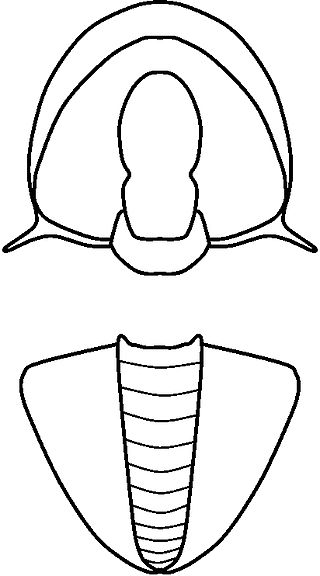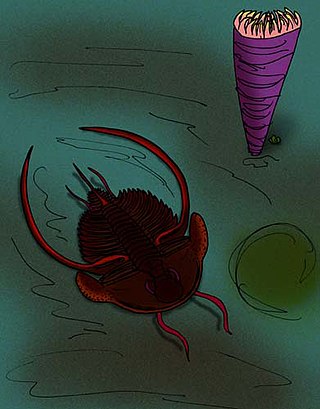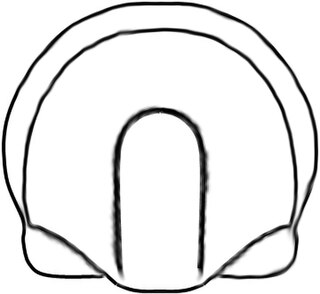
Redlichiida is an order of trilobites, a group of extinct marine arthropods. Species assigned to the order Redlichiida are among the first trilobites to appear in the fossil record, about halfway during the Lower Cambrian. Due to the difficulty to relate sediments in different areas, there remains some discussion, but among the earliest are Fallotaspis, and Lemdadella, both belonging to this order. The first representatives of the orders Corynexochida and Ptychopariida also appear very early on and may prove to be even earlier than any redlichiid species. In terms of anatomical comparison, the earliest redlichiid species are probably ancestral to all other trilobite orders and share many primitive characters. The last redlichiid trilobites died out before the end of the Middle Cambrian.

Olenellus is an extinct genus of redlichiid trilobites, with species of average size. It lived during the Botomian and Toyonian stages (Olenellus-zone), 522 to 510 million years ago, in what is currently North-America, part of the palaeocontinent Laurentia.

Acontheus is a genus of trilobites belonging to the Family Corynexochidae, Order Corynexochida, and is geographically widespread having been recorded from middle Cambrian strata in Sweden, Newfoundland, Germany, Siberia, Antarctica, Queensland, China and Wales.

Acidiscus Rasetti, 1966, is a genus of Eodiscinid trilobite belonging to the family Weymouthiidae Kobayashi T. (1943), Order Agnostida Salter (1864). It lived during the Botomian stage = late Lower Cambrian Stage 4 ; the upper Botomian boundary corresponds to base of the Middle Cambrian, Miaolingian Series and Wuliuan stage.

Acimetopus Rasetti, 1966, is a genus of Eodiscinid trilobite belonging to the family Weymouthiidae Kobayashi (1943), Order Agnostida Salter (1864). It lived during the Botomian stage. = late Lower Cambrian Stage 4 ; the upper Botomian boundary corresponds to base of the Middle Cambrian, Miaolingian Series and Wuliuan stage.

Analox Rasetti, 1966 is a genus of Eodiscinid trilobites belonging to the family Weymouthiidae Kobayashi T. (1943), Order Agnostida It lived during the Botomian stage. It can easily be distinguished from other trilobites by the two furrows that extend forwards and sidewards from the front of the glabella.
Cirquella is an extinct genus from a well-known class of fossil marine arthropods, the trilobites. It lived during the Atdabanian stage, in the former continent Laurentia.
Egyngolia is a genus of very small sized Trilobites, that lived during the Lower Cambrian in what are today the Russia Federation, Mongolia, and South Australia.

Meteoraspis is an extinct genus of ptychopariid trilobites of the family Tricrepicephalidae. The various species lived from 501 to 497 million years ago during the Dresbachian faunal stage of the late Cambrian Period. Fossils of Meteoraspis are characteristic of Late Cambrian strata in North America, though they are found in Late Cambrian strata elsewhere in the world, such as M. nevensis from Victoria Land, Antarctica.

Nephrolenellus is an extinct genus of trilobite, fossil marine arthropods, of relatively small size. Currently two species are attributed to it. Nephrolenellus lived at the end of the Lower Cambrian. Species are known from the Great Basin of California, Nevada and Arizona, with one specimen from Canada.

Mesonacis is an extinct genus of trilobite that lived during the Botomian, found in North-America, and the United Kingdom. Some of the species now regarded part of Mesonacis, have previously been assigned to Angustolenellus or Olenellus (Angustolenellus). Angustolenellus is now regarded a junior synonym of Mesonacis.
Lotagnostus is a genus of very small trilobites in the order Agnostida, which lived on the outer continental shelves worldwide, during the late Upper Cambrian. It was described by Whitehouse in 1936, and the type species is Lotagnostus trisectus, which was originally described as a species of Agnostus by Salter in 1864.

Peachella is an extinct genus of trilobites, fossil marine arthropods, with species of average size. It lived during the Toyonian stage, 516 to 513 million years ago, in what is today the southwestern United States. It can easily be distinguished from other trilobites by its club-like genal spines.

Mallagnostus Howell, 1935, is a trilobite genus belonging to the family Weymouthiidae Kobayashi T. (1943), Order Agnostida Salter (1864) according to Whittington et al. 1997. It lived during the late Lower Cambrian, with remains found in USA, Canada (Newfoundland), Spain, England, Russia, Mongolia, and the early Middle Cambrian as reported from China and Russia (Yakutia).

The Peronopsidae comprise the earliest family of the Agnostina suborder. Species of this family occurred on all paleocontinents. The earliest representatives of this family first occur just before the start of the Middle Cambrian, and the last disappeared just after the start of the Upper Cambrian.

The Weymouthiidae are an extinct family of eodiscinid agnostid trilobites. They lived during the late Lower Cambrian and earliest Middle Cambrian in the so-called Olenellus- and Eokochaspis-zones in the former paleocontinents of Laurentia, Avalonia, Gondwana. The Weymouthiidae are all blind and lack free cheeks.
Diplorrhina Hawle and Corda (1847) is a genus of trilobite belonging to Order Agnostida. It lived during the early Middle Cambrian in what are now the Czech Republic and the North Siberian plateau. as in members of the family Peronopsidae it lacks a preglabellar furrow. Both cephalon and pygidium lack spines. It is difficult to distinguish Diplorrhina from many other peronopsids.

Orygmaspis is a genus of asaphid trilobite with an inverted egg-shaped outline, a wide headshield, small eyes, long genal spines, 12 spined thorax segments and a small, short tailshield, with four pairs of spines. It lived during the Late Cambrian in what are today Canada and the United States.

Tricrepicephalus is an extinct genus of ptychopariid trilobites of the family Tricrepicephalidae with species of average size. Its species lived from 501 to 497 million years ago during the Dresbachian faunal stage of the late Cambrian Period. Fossils of Tricrepicephalus are widespread in Late Cambrian deposits in North America, but is also known from one location in South America. Tricrepicephalus has an inverted egg-shaped exoskeleton, with three characteristic pits in the fold that parallels the margin of the headshield just in front of the central raised area. The articulating middle part of the body has 12 segments and the tailshield carries two long, tubular, curved pygidial spines that are reminiscent of earwig's pincers that rise backwards from the plain of the body at approximately 30°.
Anabaraspis is a genus of redlichiid trilobite, A. splendens occurs in the uppermost Lower Cambrian and lowest Middle Cambrian of Russia. In Anabaraspis, there is an extended area in front of the glabella which is not differentiated in a border and a preglabellar field. It is a unique character in the family Paradoxididae.














